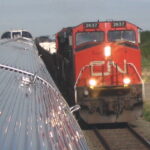Please DO Tip in the Dining Car.
Many sleeping car passengers think they don’t need to tip in an Amtrak dining car because their meals are “free”. Of course that’s not true because the cost of their meals is included in the fare they paid for their sleeping car accommodations.
As to how much to tip, I do as I would in any restaurant, basing the amount of the tip on the cost of my meal as shown on the menu.
I have heard the argument that a token tip is all that’s necessary because Amtrak employees are all unionized and are, therefore, well paid, whereas servers in restaurants are paid much less and depend upon their tips to provide a living wage.
That’s all true, but I submit that working in an Amtrak diner, especially on one of the western trains, is a much tougher job than being a server in a conventional restaurant. As an example, let’s consider what’s in store for the dining car crew leaving Chicago on Monday afternoon on the California Zephyr.
The train departs at 2:00 p.m. and the first meal to be served is dinner that night, with the first sitting probably starting around 5:30. It’s almost always a full train, so the last passenger probably won’t be leaving the diner until sometime after 8:30.
There are three meals to serve on Tuesday: breakfast begins at 6:30 and last call will be around 8:30, which means they will be serving until 9:30. Lunch will be served from 11:30 until 2:00 or so; and dinner will again be from 5:30 to 8:30 or possibly later.
There will be breakfast and lunch on Wednesday, but no dinner because the Zephyr is due into Emeryville just after 4:00 in the afternoon.
But the Chicago-based crew won’t be done. They’ll spend Wednesday night in Emeryville, then report to the train the next morning, well in advance of its 9:10 a.m. departure. They’ll be serving lunch and dinner on Thursday, three meals the next day, which is Friday, and breakfast and lunch on Saturday prior to their arrival back in Chicago around 3:00 p.m.
Assuming a typically full train, that crew will have served a total of a dozen meals to as many as 200 people over six days. And I haven’t mentioned the set-up and clean up time required for every meal.
One last point in support of tipping the dining car staff: the IRS assumes these people are receiving tips and they are taxed accordingly.
So when it comes to tipping the dining car crews, that’s my story . . . and I’m sticking to it.




Just finished my first trip on Coast Starlight between Seattle and San Francisco, I did notice that many on the trip were part of a tour that included a cruise in the Pacific northwest and a trip to Napa Valley. While not a spring chicken I was definitely on the younger side on the sleepers. I did notice that most of these people did not tip the staff during meals or sleeper attendants. When I did give a tip for excellent service to the the diner crew and sleeping car attendant they seemed very appreciative. I just wonder what the percent of the people on the train that do not tip.
Thanks for the feedback, Reid. As far as I know, there are no hard numbers. I can only go from my personal observations during a lot of Amtrak travel. I would guess that probably half the sleeping car passengers do not tip at all in the dining cars, maybe 30 percent leave a token amount, and maybe the remaining 20 percent leave a tip of 10-15 percent. But–boy!–that’s just a guess and could be way off.